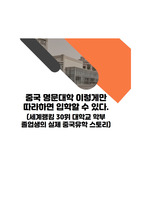Brand Image에 대한 마케팅 영문논문,
*우*
다운로드
장바구니
소개글
영국에서 학사를 졸업할때 쓴 논문입니다.통계자료와 이미지 그리고 설문조사까지 모두 첨부되어있으며,
문법검수 다시 받으실 필요 없습니다.
목차
1. The beginnings of brand imaging1-1. The Impact on population and growing literacy on brand imaging and the power of advertising
1-2. The power of print advertising over sales techniques and advertising
2. The importance of having a strong brand image in an increasingly crowded retail environment
3. Market research and its effect on directed advertising
4. The impact of technology and changing models on static branding and how the consumer is kept engaged
5. Research project
6. Conclusion
References
본문내용
‘Advertisements are now so numerous,’ wrote Dr Samuel Johnson in 1759, ‘that they are negligently pursued and it is therefore become necessary to gain attention by magnificence of promises and by eloquence sometimes sublime and sometimes pathetic. Promise, large promise, is the soul of advertisement.’Although society has moved on since Johnson’s time, the same basic concept holds good. Today, selling is all about brand image, to the extent that marketers talk of a ‘total personality’ of a brand that triggers an instant response in the mind of the consumer. Technology, whether it is the printing press, the camera, television or the Internet, means that brand images can be projected onto our minds and reinforced by regular viewing. Brands become not just ‘acquaintances, but friends.’
As society becomes ever more sophisticated, trends in consumership change. In the past, small scale companies could only reach a small audience via local advertising and the concept of a brand image was not appropriate or necessary.
참고 자료
Brinkley, Alan, (1983) American History: A Survey, Knopf.Church, Roy and Godley, Andrew, (2003) The Emergence of Modern Marketing: International Dimensions London: Cass
Gunter, Barrie & McAleer, Jill L. (1997) Children and Television. Second edition. London: Routledge.
Keller, K. L. and Aaker, D. A. (1998) 'Corporate-level marketing: The impact of credibility on a company's brand extensions', Corporate Reputation Review, Vol. 1, No. 4 (August), pp. 356–378.
Meyers, Herbert and Gerstman, Richard (2001) Branding @ the Digital Age London: Palgrave
Norris, James D (1990) Advertising and the Transformation of American Society 1865-1920 Greenwood.
Painter, George D, (1976) William Caxton, Chatto and Windus.
Reilly R., & Savage, G. The Dictionary of Wedgwood. (Antique Collectors’ Club, 1980).
Schultz, M., Antorini, Y. M. and Fabian, F. C., (eds) (2005) 'Corporate branding: Purpose, people, and processes', Copenhagen Business School Press, Herndon, VA.
Trow, M J, (2001) Who Killed Kit Marlowe Sutton.
Aaker, David(1991), Managing Brand Equity: Capitalizing on the Value of a Brand Name, New York : The Free Press.
David(1996), Building Strong Brands, New York : The Free Press.
Aaker, Jennifer(1997), "Dimensions of Brand Personality", Journal of Marketing Research, 34(August), pp. 347-356.
Batra, R & Ray, M.L.(1985), "How Advertising Works at Contact", In I. F. Alwitt & A. A. Mitchell(des.), Psychological Process and Advertising Effects : Theory & Research & Applications, Hillsdale, NJ : Lawrence Erlbaum Association pp.13-44.
Belk, Russel W.(1988). "Possessions and the Extended Self", Journal of Consumer Rearch, 15(Sept), pp. 139-168.
Biel, Alexander(1993), "Converting Image into Equity", in Brand Equity and Advertising In David A. Aaker & Alexander Biel(eds.), Hillsdale, NJ : Lawrence Erlbaum Association.
Cohen, Joel(1967), "Interpersonal Orientation to the Study of Consumer Behavior", Journal of Marketing Research, pp.270-278.
Dolich, Ira J.(1969), "Congruence Relationships Between Self-Images and Product Brands", Journal of Marketing Research, Vol.6, February, pp.80-85.
Fournier, Susan(1994), "A Consumer-Brand Relationship Framework for Strategy Brand Management", unpublished doctorial dissertation, University of Florida.
Keller, Kevin L.(1993), "Conceptualizing, Measuring, and Managing Customer-Based Brand Equity", Journal of Marketing, 57(January), pp. 1-22.
Kleine, Susan Schultz, Kleine, Robert E. & Kernan, Jerome B(1993), "Mundane Consumption and th Self: A Social-Identity Perspective", Journal of Consumer Psychology, 2(3), pp.209-235.
Kotler, Philip(1997), Marketing Management, Upper Saddle River, NJ : Prentice Hall.
Ladon, E. Laird, Jr.(1974). "Self-Concept, Ideal Self-Concept, and Consumer Purchase Intentions", Journal of Consumer Research, 1, September, pp.44-51.
Levy, Sidney J.(1959), "Symbols for Sale", Harvard Business Review, July/August pp.117-124.
Malhotra, Naresh K.(1981), "A Scale to Measure Self-Concepts, Person concepts and Product Concepts", Journal of Marketing Research, 23(November), pp. 456-464. (1988), "Self Concept and Product Choice : An Integrated perspective", Journal of Economic Psychology, 9, pp.1-28.
Petty, Richard E., Cacioppo, John T,. & David Schumman(1983), "Central and Peripheral Routes to Advertising Effectiveness : The Moderating Role of Involvement", Journal of Consumer Research, Vol,10, pp.135-146.
Plummer, Joseph T.(1985), "How Personality Makes a Difference", Journal of Advertising Research, 24(6), pp.27-31.
Rokeach, Milton(1973), The Nature of Human Values, N.Y. : The Nature of human Values, N.Y : The Free Press, p.5.
Sirgy, Joseph(1982), "Self-Concept in Consumer Behavior : A Critical Review", Journal of Consumer Research, 9(December), pp. 287-300.
Zaichkowsky, J. L.(1985), "Familiarity : Product Use, Involvement, or Expertise?", In R. J. Lutz(eds.), in Advances in Consumer Research, Vol.13, Provo, UT : Association for Consumer Research, pp,296-299. (1985), "Measuring the Involvement Construct", journal of Consumer Research, 12, pp.341-352.
Telegraph, Waterford Wedgwood – a history in pictures, available online at
http://www.telegraph.co.uk/finance/newsbysector/retailandconsumer/4123998/Waterford-Wedgwood-a-history-in-pictures.html?image=1
Winkler, Agnieszka, (1999) Warp-Speed Branding: The Impact of Technology on Marketing London: Wiley



























